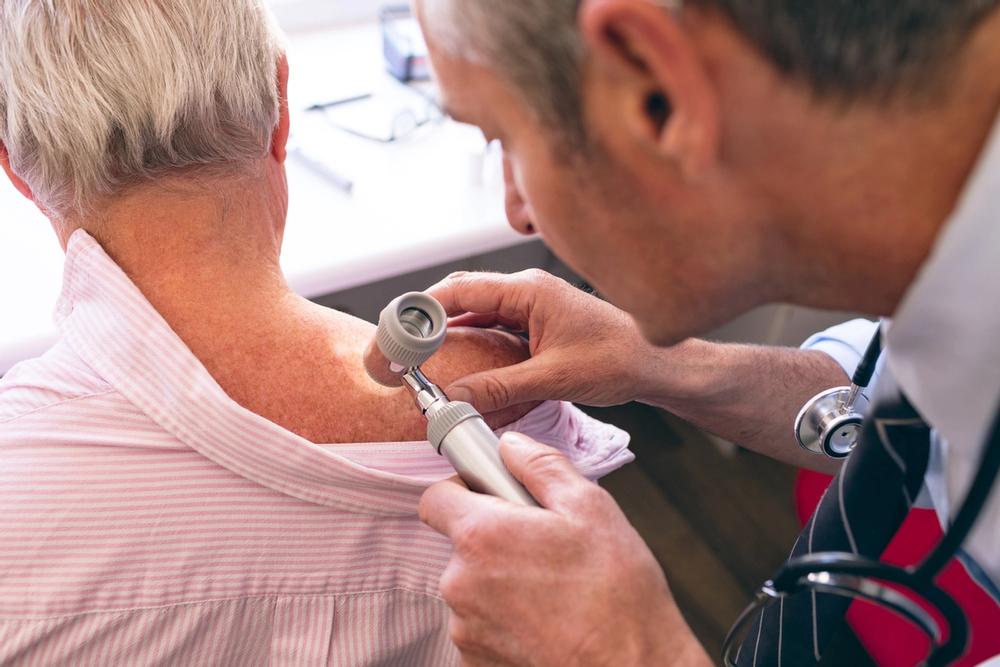- Center on Health Equity & Access
- Clinical
- Health Care Cost
- Health Care Delivery
- Insurance
- Policy
- Technology
- Value-Based Care
Mohs Surgery Improves Outcomes Over WLE for Merkel Cell Carcinoma
Despite conventional guidelines, Mohs micrographic surgery (MMS) may be more effective than wide local excision (WLE) for treatment of localized tumors.
A study on overall survival after Mohs micrographic surgery (MMS) for early-stage Merkel cell carcinoma (MCC) found MMS was associated with significant improvement compared with survival in patients who underwent conventional wide local excision (WLE).
This national retrospective cohort study was published in JAMA Dermatology. The authors limited their analysis to Tumor 1/Tumor 2 (T1/T2) MCC because these tumors are more amenable to any surgical approach.
"For those with localized disease, it is generally accepted that surgery is the most effective definitive treatment option," they explained. "However, there is some controversy as to the optimal surgical approach for these cases."
MCC is a rare type of skin cancer with a propensity to rapidly metastasize to regional lymph nodes, in which current National Comprehensive Cancer Network guidelines recommend sentinel lymph node biopsy. This study compared the use of MMS with WLE to assess overall survival in patients with localized MCC with pathologically confirmed negative lymph nodes.
Doctor screening a patient for skin cancer.

The study included data from the National Cancer Database (NCDB) in adults with T1/T2 MCC who were diagnosed from January 1, 2004, to December 31, 2018, who had been treated with surgery. A total of 22,610 patients were identified.
Patients were excluded if they had positive lymph node disease, were missing data on clinical lymph node status, had clinically negative distant metastatic disease, were not treated with surgical excision, without T1/T2 disease, and did not have confirmed pathologically negative lymph node(s). Furthermore, patients were excluded if they had other nonkeratinocyte malignant neoplasms or were diagnosed after 2019 because of a lack of survival data on these patients.
After exclusion, 2313 patients were met all inclusion criteria. The mean (SD) age of patients was 71 (10.6) years, with 1340 (57.9%) of them men.
The statistical analysis showed excision with MMS had the best unadjusted survival, with mean (SE) survival rates of 87.4% (3.4%) at 3 years, 84.5% (3.9%) at 5-years, and 81.8% (4.6%) at 10 years compared with WLE, which had mean (SE) survival rates of 86.1% (0.9%) at 3 years, 76.9% (1.2%) at 5-years, and 60.9% (2%) at 10 years.
Additionally, similar results were observed in patients who received narrow-margin excision, with mean (SE) survival rates of 84.8% (1.4%) at 3 years, 78.3% (1.7%) at 5 years, and 60.8% (3.6%) at 10 years.
Multivariable survival analysis showed excision with MMS was associated with significant improved survival outcomes compared with WLE (hazard ratio [HR], 0.59; 95% CI, 0.36-0.97; P = .014). Furthermore, high-volume MCC centers were significantly more likely to use MMS over WLE compared with other centers (odds ratio [OR], 1.99; 95% CI, 1.63-2.44; P < .001)
However, the researchers acknowledged some limitations to the study, such as being unable to collect data on locoregional recurrence of disease specific survival, the analysis was not controlled for patient immunosuppression status, and the MSS group had much fewer patients than in the WLE group. Furthermore, the researchers believe that further studies need to be done, given the lack of randomization and potential for selection bias.
“These data suggest that MMS may provide a survival benefit in the treatment of localized MCC, although further prospective work studying this issue is required,” wrote the researchers. “Future directions may also focus on elucidating the benefit of adjuvant radiotherapy in localized cases treated with MMS.”
Despite these limitations, the study shows the use of MMS may be a better treatment option for patients with early-stage MCC with pathologically confirmed negative regional lymph node disease, compared with WLE.
Reference
Cheraghlou S, Doudican NA, Criscito MC, Stevenson ML, Carucci JA. Overall survival after Mohs surgery for early-stage Merkel cell carcinoma. JAMA Dermatology. Published online August 23, 2023. doi:10.1001/jamadermatol.2023.2822
Integrated Care for Chronic Conditions: A Randomized Care Management Trial
December 3rd 2025The authors sought to understand the differential impact of payer-led community-based care management approaches on stakeholder-oriented outcomes for publicly insured adults with multiple chronic conditions.
Read More
Managed Care Reflections: A Q&A With A. Mark Fendrick, MD, and Michael E. Chernew, PhD
December 2nd 2025To mark the 30th anniversary of The American Journal of Managed Care (AJMC), each issue in 2025 includes a special feature: reflections from a thought leader on what has changed—and what has not—over the past 3 decades and what’s next for managed care. The December issue features a conversation with AJMC Co–Editors in Chief A. Mark Fendrick, MD, director of the Center for Value-Based Insurance Design and a professor at the University of Michigan in Ann Arbor; and Michael E. Chernew, PhD, the Leonard D. Schaeffer Professor of Health Care Policy and the director of the Healthcare Markets and Regulation Lab at Harvard Medical School in Boston, Massachusetts.
Read More
